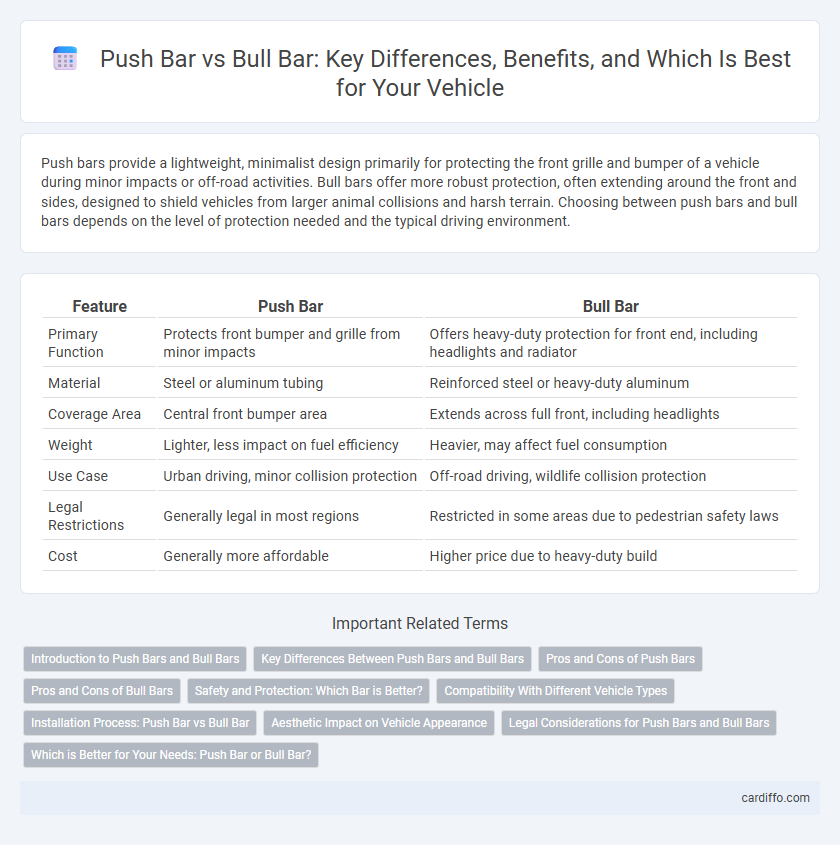Push bars provide a lightweight, minimalist design primarily for protecting the front grille and bumper of a vehicle during minor impacts or off-road activities. Bull bars offer more robust protection, often extending around the front and sides, designed to shield vehicles from larger animal collisions and harsh terrain. Choosing between push bars and bull bars depends on the level of protection needed and the typical driving environment.
Table of Comparison
| Feature | Push Bar | Bull Bar |
|---|---|---|
| Primary Function | Protects front bumper and grille from minor impacts | Offers heavy-duty protection for front end, including headlights and radiator |
| Material | Steel or aluminum tubing | Reinforced steel or heavy-duty aluminum |
| Coverage Area | Central front bumper area | Extends across full front, including headlights |
| Weight | Lighter, less impact on fuel efficiency | Heavier, may affect fuel consumption |
| Use Case | Urban driving, minor collision protection | Off-road driving, wildlife collision protection |
| Legal Restrictions | Generally legal in most regions | Restricted in some areas due to pedestrian safety laws |
| Cost | Generally more affordable | Higher price due to heavy-duty build |
Introduction to Push Bars and Bull Bars
Push bars and bull bars are vehicle accessories designed to protect the front end from damage during collisions or off-road driving. Push bars, typically mounted on the front bumper, offer lightweight protection and enhance vehicle appearance while allowing access to headlights and grille. Bull bars provide more robust defense with reinforced steel or aluminum construction, often used in rugged environments to safeguard against animal impacts and debris.
Key Differences Between Push Bars and Bull Bars
Push bars are designed primarily to protect the front bumper and facilitate vehicle pushing or towing, typically featuring a minimalistic frame that prevents damage during low-impact collisions. Bull bars offer more extensive front-end coverage, shielding critical components such as headlights and radiators from animal strikes and off-road hazards with robust, reinforced steel or aluminum construction. While push bars prioritize utility and maneuverability in urban environments, bull bars provide superior protection and durability for rugged, off-road applications.
Pros and Cons of Push Bars
Push bars offer significant protection to the front end of vehicles, effectively minimizing damage during low-speed collisions. They are typically lighter and easier to install compared to bull bars, improving vehicle aerodynamics and fuel efficiency. However, push bars provide less coverage and protection for critical components like headlights and grille, which bull bars better safeguard.
Pros and Cons of Bull Bars
Bull bars provide robust protection to the vehicle's front end, making them ideal for off-road driving and impacts with large animals. They offer superior durability and coverage compared to push bars but are heavier and can affect fuel efficiency. However, bull bars may pose higher risks in pedestrian collisions and are subject to legal restrictions in certain regions.
Safety and Protection: Which Bar is Better?
Push bars and bull bars both enhance vehicle safety by providing front-end protection, but their design impacts effectiveness differently. Push bars offer moderate protection mainly against minor impacts and can safeguard the grille and headlights, making them ideal for urban use. Bull bars deliver robust defense for off-road conditions by covering a larger front area, absorbing higher impact forces and protecting the radiator and engine components more effectively.
Compatibility With Different Vehicle Types
Push bars and bull bars vary significantly in compatibility across vehicle types due to their design and intended use. Push bars are generally compatible with a wide range of passenger vehicles and light trucks, offering moderate front-end protection without major modifications. Bull bars, often designed for off-road and heavier utility vehicles, provide robust protection but may require specific vehicle mounts and are less suited for compact or aerodynamic cars.
Installation Process: Push Bar vs Bull Bar
Push bars typically feature a straightforward installation process involving mounting brackets that bolt directly to existing frame points, often requiring minimal modifications. Bull bars, on the other hand, demand a more complex installation involving reinforcement to the vehicle's chassis, sometimes necessitating professional alignment and additional wiring for integrated lighting. Installation time for push bars averages around one to two hours, whereas bull bars can take upwards of three to four hours depending on vehicle type and equipment.
Aesthetic Impact on Vehicle Appearance
Push bars feature a sleek, minimalistic design that enhances a vehicle's rugged yet modern look, seamlessly blending with the front grille without overwhelming the overall aesthetic. Bull bars, often larger and more robust, create a bold, aggressive appearance that emphasizes off-road capability and protection but can dominate the vehicle's front profile. Choosing between push bars and bull bars depends on the desired balance between subtle style and striking toughness in vehicle accessories.
Legal Considerations for Push Bars and Bull Bars
Push bars and bull bars must adhere to specific legal regulations that vary by region, often focusing on vehicle safety and pedestrian protection standards. Many jurisdictions require that these accessories meet crash test certifications and restrictions on materials or design to minimize injury risks during collisions. Failure to comply with these legal considerations can result in fines, vehicle registration issues, or mandatory removal of the accessory.
Which is Better for Your Needs: Push Bar or Bull Bar?
Push bars and bull bars serve distinct protective and functional roles for vehicles, with push bars primarily designed to assist in moving obstacles and providing light front-end protection, while bull bars offer more robust defense against animal collisions and off-road impacts. Choosing between a push bar or bull bar depends on your driving environment, vehicle type, and specific needs such as urban pushing capabilities versus rugged off-road protection. For urban and light-duty applications, push bars are efficient and lightweight; for off-road enthusiasts or those in rural areas prone to wildlife encounters, bull bars deliver superior durability and comprehensive frontal protection.
Push Bar vs Bull Bar Infographic

 cardiffo.com
cardiffo.com